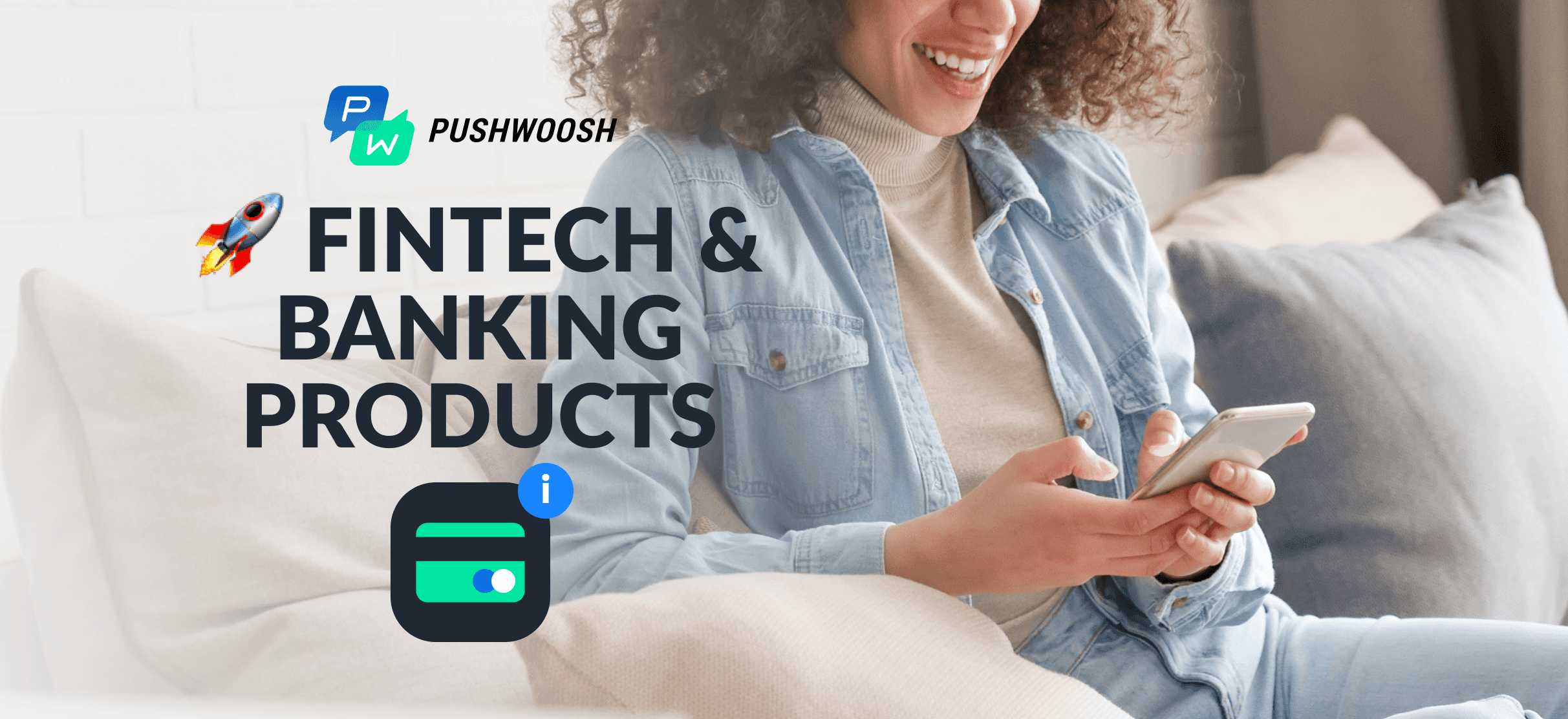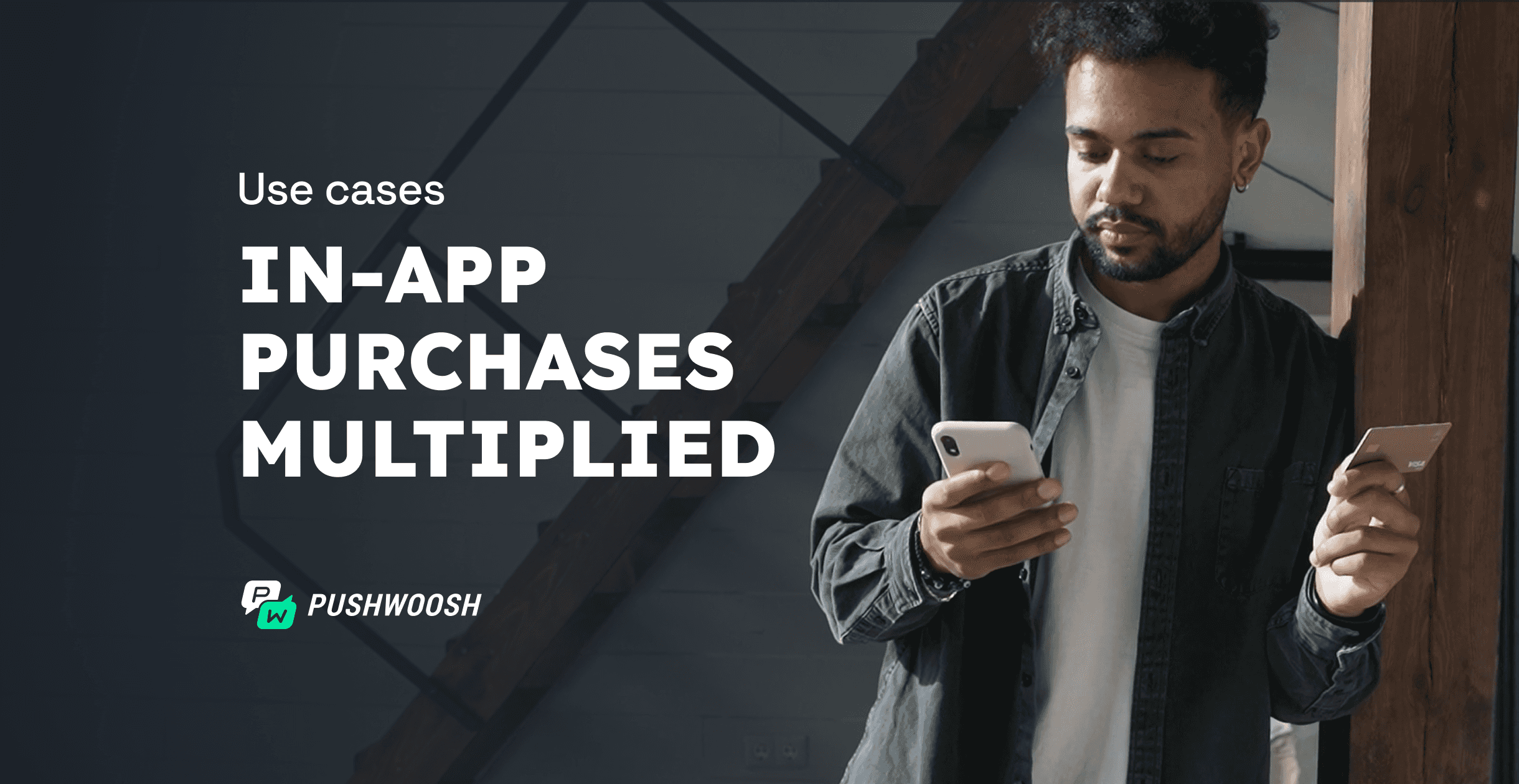Holiday marketing 2025: Expert strategies to maximize sales during the holiday season + examples
What if this holiday season 2025, your biggest win wasn’t from discounts, but from a smart holiday marketing strategy? As inboxes overflow and ad costs skyrocket, marketers who plan early, segment smarter, and automate their campaigns will be the ones celebrating record sales.
In this guide, you’ll learn how to launch a high-performing holiday marketing strategy — based on expert insights and powered by Pushwoosh, the omnichannel customer engagement platform.
When to start your holiday season campaign (2025 holiday marketing calendar)
Holiday success starts long before December. The brands that see the biggest spikes in sales are those that treat holiday season marketing as a months-long strategy, not a one-week sprint. Planning early gives you time to test creatives, warm up audiences, and automate every touchpoint before the rush begins.
Holiday campaign planning should start early (typically by late summer or early fall) to make sure assets, app/website updates, and promo campaigns are ready well before the high-traffic shopping and engagement season.
For e-commerce, you’re building around the tentpole event of Black Friday. You want to have your strategy dialed in well ahead of time, ideally settled on before October, to leave room for adjustments.
Here’s your 2025 holiday marketing calendar — a roadmap to help your campaigns stay ahead of the curve:
| Month | Focus | Key actions |
|---|---|---|
| August–September | Planning & preparation | Finalize your holiday campaign strategy, update your app store listing, test your audience segments, and build automated flows in advance. |
| October | Pre-holiday warm-up | Launch teaser campaigns, encourage opt-ins, and re-engage inactive users. Use soft promos to build anticipation for upcoming sales. |
| November | Conversion peak | Run your Black Friday, Cyber Monday, and early holiday deals. Automate real-time triggers for high-intent users (abandoned cart, viewed product, etc.). |
| December | Festive momentum | Keep engagement high with personalized offers, gift guides, and loyalty rewards. Optimize message timing for last-minute shoppers. |
| January | Post-holiday retention | Run “thank-you” and re-engagement campaigns. Encourage app reviews, referrals, and early New Year sales. |
Different industries should approach this calendar strategically because their focus might be less targeted on the specific event, and it can make sense to spread campaigns out and intentionally avoid the BFCM peak:
Health & wellness is focused more on end-of-year resets and motivation going into the upcoming year.
Media apps may get less attention around Black Friday, but build their strategy around year-end reviews that drive retention and new annual subscriptions.
Gaming apps aim for downtime-driven engagement windows, such as the winter break.
The power of holiday marketing automation
While promotional blasts get the most attention, automated campaigns tailored to the customer lifecycle are the ones that drive even more substantial results year-round, including during holidays:
MobiLoud data shows that automated push campaigns drive 21% of all push-attributed orders, despite being only 3% of total sends. These are your cart abandonment messages, welcome messages, and automatic upsells. These messages are timely and highly relevant, which is why they typically drive the strongest results.
Make your app impossible to ignore during the holiday season battle
Your app store page is the first touchpoint for potential customers — and during the holidays, it’s also your most crowded battlefield. Shoppers are actively searching for deals, entertainment, or inspiration. If your listing looks the same as it did in July, you’re invisible.
The holiday season turns the App Store into the Champions League of visibility battles. Everyone’s launching offers, updating creatives, and bidding like there’s no January.
That’s why I like to focus on the fundamentals that actually drive impact:
- Your icon is your first impression. Make sure it’s festive but still recognizably yours.
- Don’t just cram in seasonal keywords like “Christmas.” Instead, consider localized trends and long-tail variations that convert.
- And for offers? Make them visible in-store, not just in-app. Think custom product pages, IAE, or creative updates that tease value early.
It’s about being festive and functional. You only get a few seconds of attention, so make them count.
Master holiday-themed creatives that drive urgency
Visual elements communicate faster than text, especially during the hectic holiday season when users scroll quickly through crowded feeds and notifications. Your creative assets need to capture attention instantly while conveying both seasonal relevance and clear value.
The right visuals don’t just decorate your message — they drive clicks, conversions, and repeat visits.
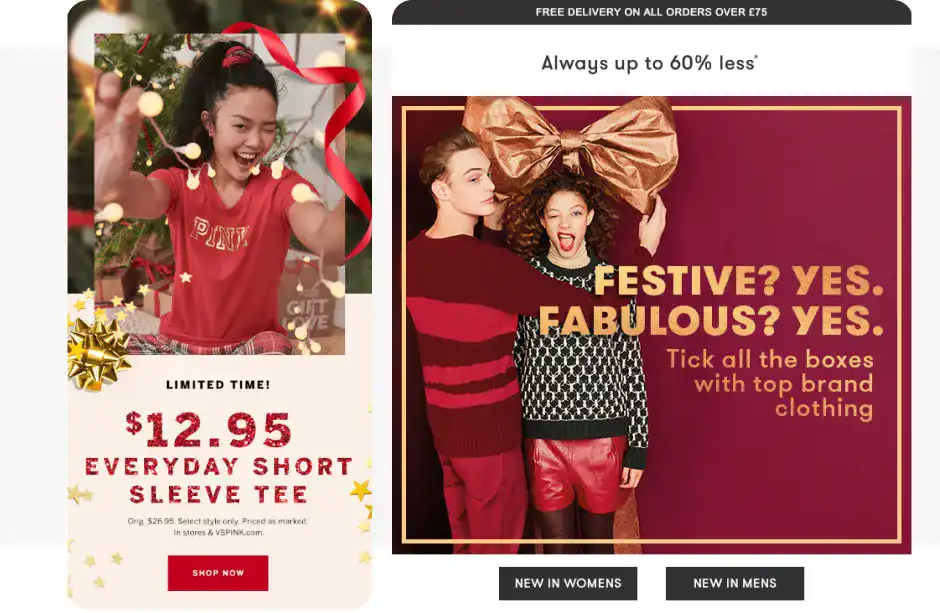
Here’s how to make your holiday creatives stand out:
❄️ Tap into emotion
Use visuals that evoke warmth, generosity, and excitement — twinkling lights, cozy textures, or celebration scenes.
❄️ State the offer visually
Don’t make users read fine print. Show discounts, gift bundles, or countdowns directly on the image.
❄️ Stay on-brand
Seasonal doesn’t mean off-brand. Keep your palette, logo, and typography consistent so users recognize you instantly.
❄️ Design for mobile first
Most users will see your visuals in-app or in their notifications feed. Keep text short and focal points clear.
❄️ Test motion
Subtle animation (like shimmering text or falling snow) draws attention without overwhelming users.
Build urgency with timely offers
Holiday shoppers love a good deal — but it’s the timing that drives action. Limited-time offers, countdowns, and flash sales turn passive browsers into instant buyers by tapping into urgency and FOMO.
Here’s how to do it right:
⚡️Run flash sales with clear time limits
A “24-hour deal” or “ending tonight” message performs far better than a week-long generic discount.
⚡️ Use countdown timers across channels
Display timers in push notifications, in-app messages, and emails to remind users how little time is left.
⚡️ Reward early buyers
Offer “early bird” access to loyal or high-spending users before the general sale — they’ll appreciate the exclusivity.
⚡️ Keep momentum
Rotate daily or hourly deals to maintain interest without overwhelming your audience.
⚡️ Add urgency to messaging
Phrases like “Only 3 left!” or “Offer ends at midnight” make your call to action irresistible.
Focus on re-engagement over acquisition
It’s tempting to chase new users during the holidays — but your biggest wins often come from those who already know your brand. Returning customers generate around 65% of total revenue for most businesses.
Retaining customers is also far more efficient: it’s five times more cost-effective than acquiring new users, especially during the holiday season when ad costs skyrocket and competition peaks.
So, instead of pouring your entire budget into acquisition ads, focus on re-engagement. Reactivate dormant users, reward loyal ones with early access, and remind everyone why they loved your app or store in the first place.
Here are smart ways to re-engage effectively:
🎁 Send “We miss you” reminders
Combine push notifications and email to bring lapsed users back with a personalized incentive or a free shipping code.
🎁 Reward loyalty
Offer exclusive early-bird deals or bonus rewards to your most active customers.
🎁 Re-target active app users
Trigger in-app messages for those who browse but don’t purchase — show relevant recommendations or last-minute gift bundles.
🎁 Create a post-purchase loop
Follow up with thank-you messages, cross-sell ideas, or referral bonuses to keep engagement flowing after checkout.
Segmentation: The foundation of effective holiday campaigns
Generic, one-size-fits-all promotions are easily ignored during holiday campaigns. Attentive’s 2025 study shows that 81% of consumers skip irrelevant messages, while 96% are ready to buy when the content feels personalized.
To truly connect, you need to segment your audience and tailor every offer to their behavior, not just their demographics.
Here are some segmentation ideas to use in your holiday marketing strategy:
Depending on their purchase history:
- Frequent buyers
- Cart abandoners
- Product browsers
- Silent users
- VIP customers
- Category buyers
- Any other types you can derive from RFM segmentation
Depending on their engagement with your app and communications:
- Recent openers
- Message ignorers
- Inactive subscribers
Depending on their shopping patterns:
- Seasonal shoppers
- Gift givers
- Discount seekers
- Last-minute buyers
- Wishlist users
- Online shoppers
You can easily segment users by behavior or attributes inside Pushwoosh and automatically send relevant messages to each category using Customer Journey Builder.
For example, you can segment all users who have triggered the “App Open” event, then split them by whether they’ve previously made an offline purchase*.* While new users receive a welcome message with onboarding tips or a first-purchase discount, existing offline buyers get reactivation messages encouraging them to shop online.

Or you may target customers who have indicated their birthday date in December and send them an email with ideas for their wishlist.

Personalize your holiday messaging
Once you’ve built your segments, the next step is turning them into meaningful interactions. Personalization is what transforms generic promos into messages that feel tailor-made — and it’s easier than it sounds.
For example, frequent buyers who’ve added items to their favorites can receive in-app messages or push notifications that reference those exact products. Meanwhile, shoppers who haven’t selected any favorites can get personalized product recommendations from your brand.

To take personalization even further, use Dynamic content to tailor each message individually. Automatically insert a user’s name, product name, categories, or discount amounts, ensuring every recipient gets a message that feels like it was written just for them.
Synchronize holiday messaging across channels
Holiday shoppers move fast — from inbox to app to website — and your messaging should follow them seamlessly. A push notification might grab their attention, but it’s the follow-up email or in-app message that often drives the final conversion.
The key is consistency. Keep your offers, visuals, and tone aligned across channels so users recognize your message instantly, wherever they see it.
Different channels serve different purposes within your holiday marketing strategy:
- Push notifications deliver immediate attention for flash sales, countdown reminders, and time-sensitive holiday offers. High visibility but requires opt-in, making early relationship-building crucial.
- In-app messages provide contextual promotions delivered when users actively engage with your app. Perfect for upsells, cross-sells, and showcasing special holiday features and seasonal content.
- Email enables detailed product showcases, comprehensive gift guides, longer-form holiday content, and offers requiring more explanation. Higher character limits than push allow storytelling.
- SMS and WhatsApp messages serve for urgent reminders, delivery updates, and last-minute holiday deals.
Holiday marketing campaign examples for your inspiration
Learning from successful brands accelerates the development of your own holiday season marketing strategy. Here are proven festive marketing ideas from companies that consistently win during the holiday period:
Blinkist — digital gifting
Subscription-based edtech app Blinkist positioned its premium subscription as “A gift they’ll actually use.”
Why it works: Solves a relatable holiday problem, positioning the product as smart, personal, and easy to gift.
Strategy tips:
- Segmentation: Users who engaged with gift-related content or visited the “Gifting” page.
- Idea for personalization: Highlight categories of interest (productivity, wellness, learning).

Calm — holiday self-care offer
Meditation and mental wellness app Calm reframed the holidays as a time for mindfulness, offering 50% off premium access with the line “Your secret to surviving the holidays.”
Why it works: Moves beyond discounts — connects emotionally with an audience overwhelmed by the season.
Strategy tips:
- Segmentation: Active free users or trial-ended users.
- Timing: Mid to late December, just before the holiday break.
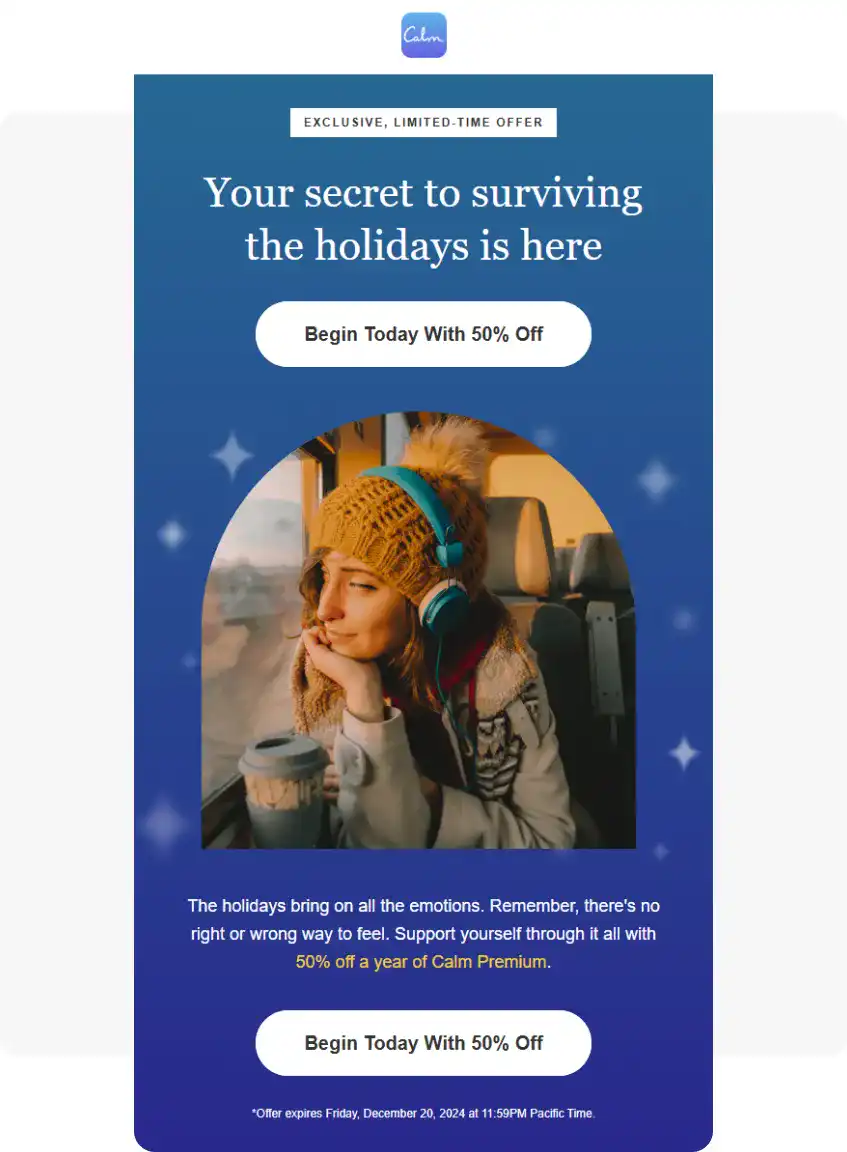
Lush — advent calendar experience
Cosmetics brand Lush’s holiday season campaign showcased exclusive advent calendars and gift sets.
Why it works: Builds anticipation and encourages early purchases.
Strategy tips:
- Segment: Past buyers + high-engagement app users.
- Timing: Early November to catch pre-Christmas planners.
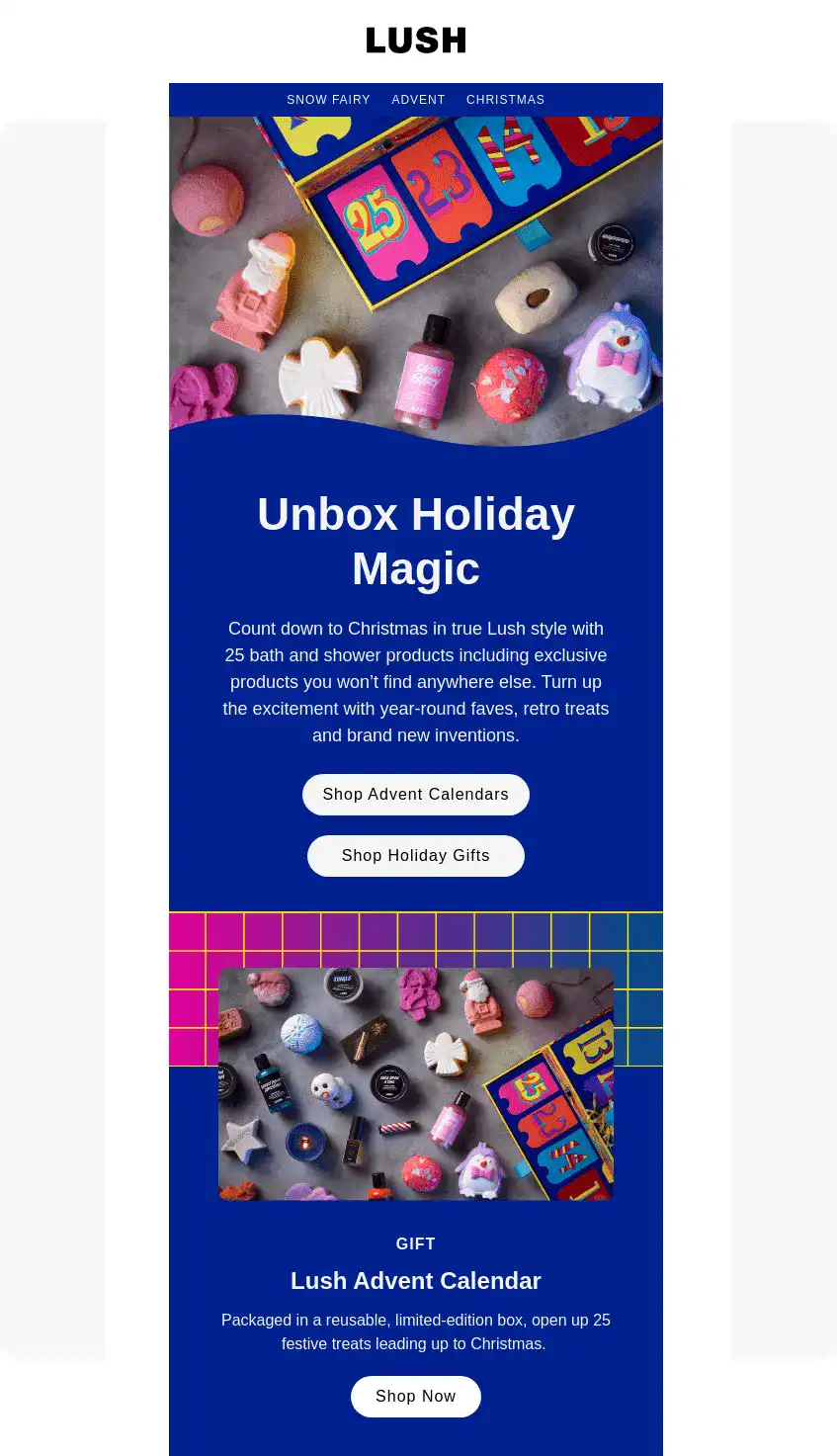
H&M — holiday product recommendations
E-commerce brand H&M’s “Holiday classics” campaign highlighted cozy seasonal decor and shoppable collections.
Why it works: Inspires gift planning and boosts average order value through curated, lifestyle-driven visuals.
Strategy tips:
- Segment: Browsers who interacted with home/decor categories.
- Timing: November–December to drive early inspiration and last-minute sales.

Airbnb — last-minute gift cards
Global travel platform Airbnb’s “The gifts you need in record speed” campaign promoted instantly delivered digital gift cards for last-minute gift shoppers.
Why it works: Tackles last-minute buyer anxiety with convenience and instant fulfillment.
Strategy tip:
- Timing: The week before Christmas.
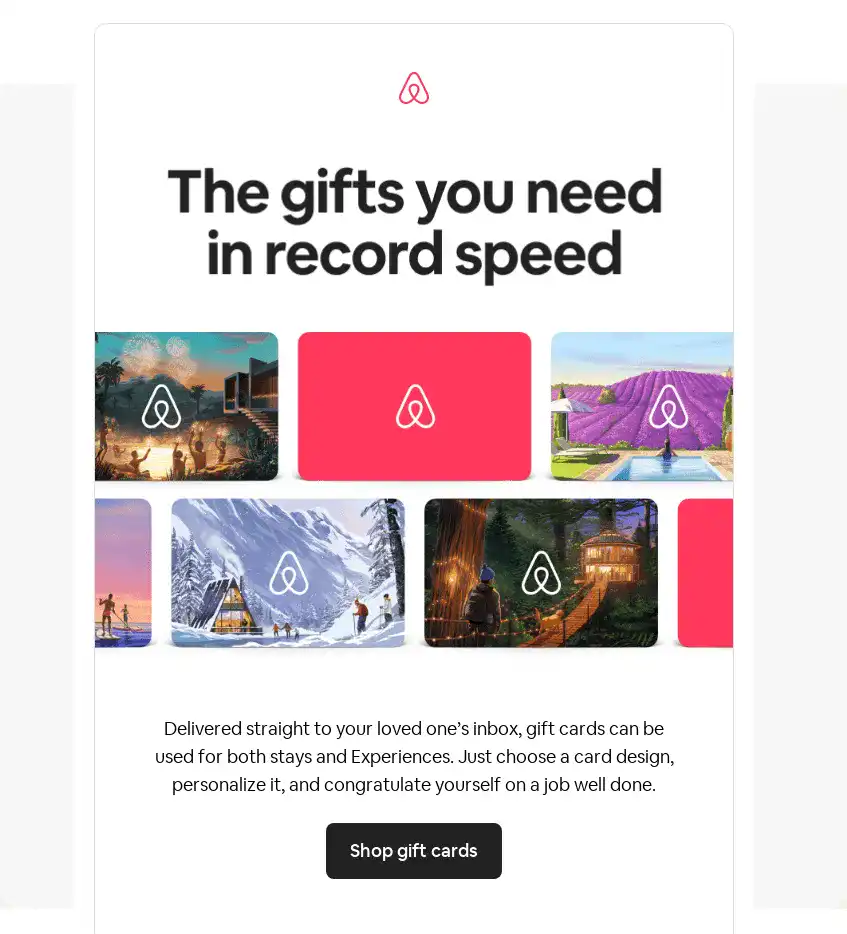
Hims — holiday gift guides
Men’s wellness brand Hims created a holiday gift guide with curated sets, offering 25% off and guaranteed delivery by Christmas Eve.
Why it works: Clear offer, smart bundling, and urgency — all supported by gift-set imagery that simplifies decision-making.
Strategy tip:
- Segment: Repeat buyers + users browsing the “Gifts” category.
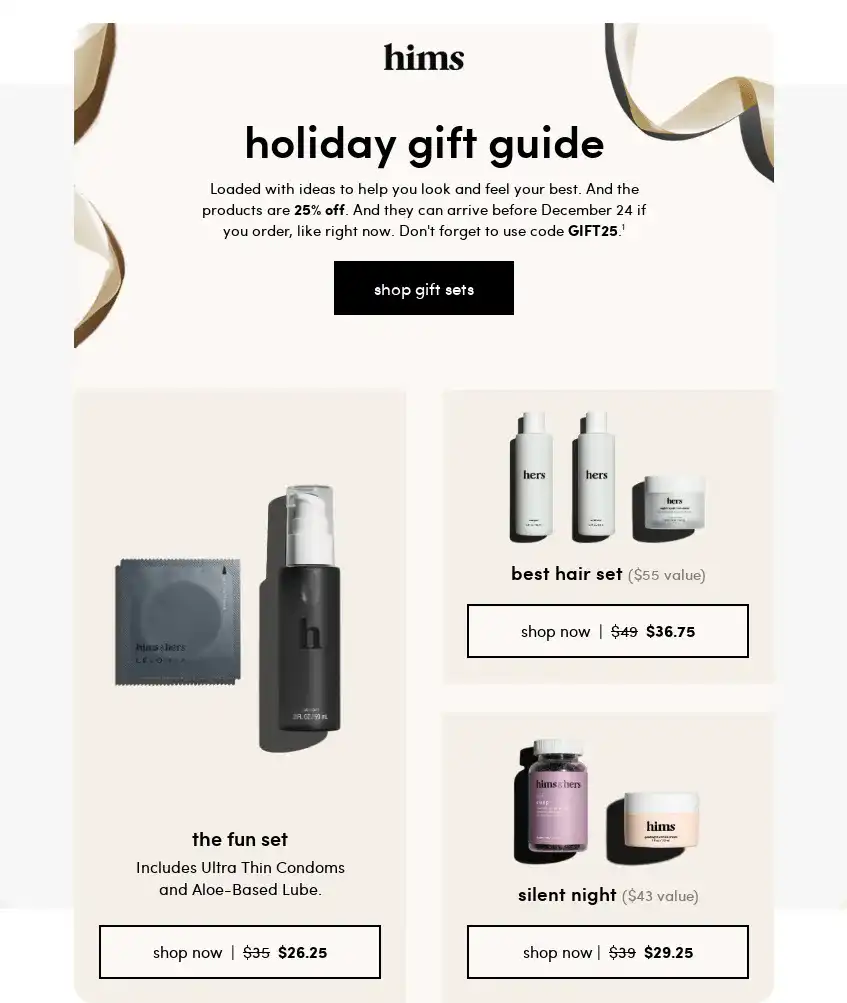
Taco Bell — festive delivery and rewards
Taco Bell, a restaurant chain with a strong app and delivery presence, announced holiday delivery with 15% off for pre-orders and encouraged app installs.
Why it works: Fun, on-brand, and perfectly timed to reach users during social gatherings and lazy evenings.
Strategy tips:
- Segment: Frequent buyers + lapsed delivery users.
- Timing: Christmas and New Year’s Eve.

Drops — New Year’s resolution
Language-learning app Drops turned January into an opportunity to re-engage users. The brand ran two connected campaigns — “Keep your New Year’s resolution” (Jan 1) and “New Year’s resolution sale — 50% off” (Jan 25).
Why it works: Perfectly timed for Q5 — leverages post-holiday motivation when users are ready to form new habits.
Strategy tips:
- Segment: New and inactive users.
- Timing: Scheduled email sequence for the first day of the year (on the left) and late January (on the right).
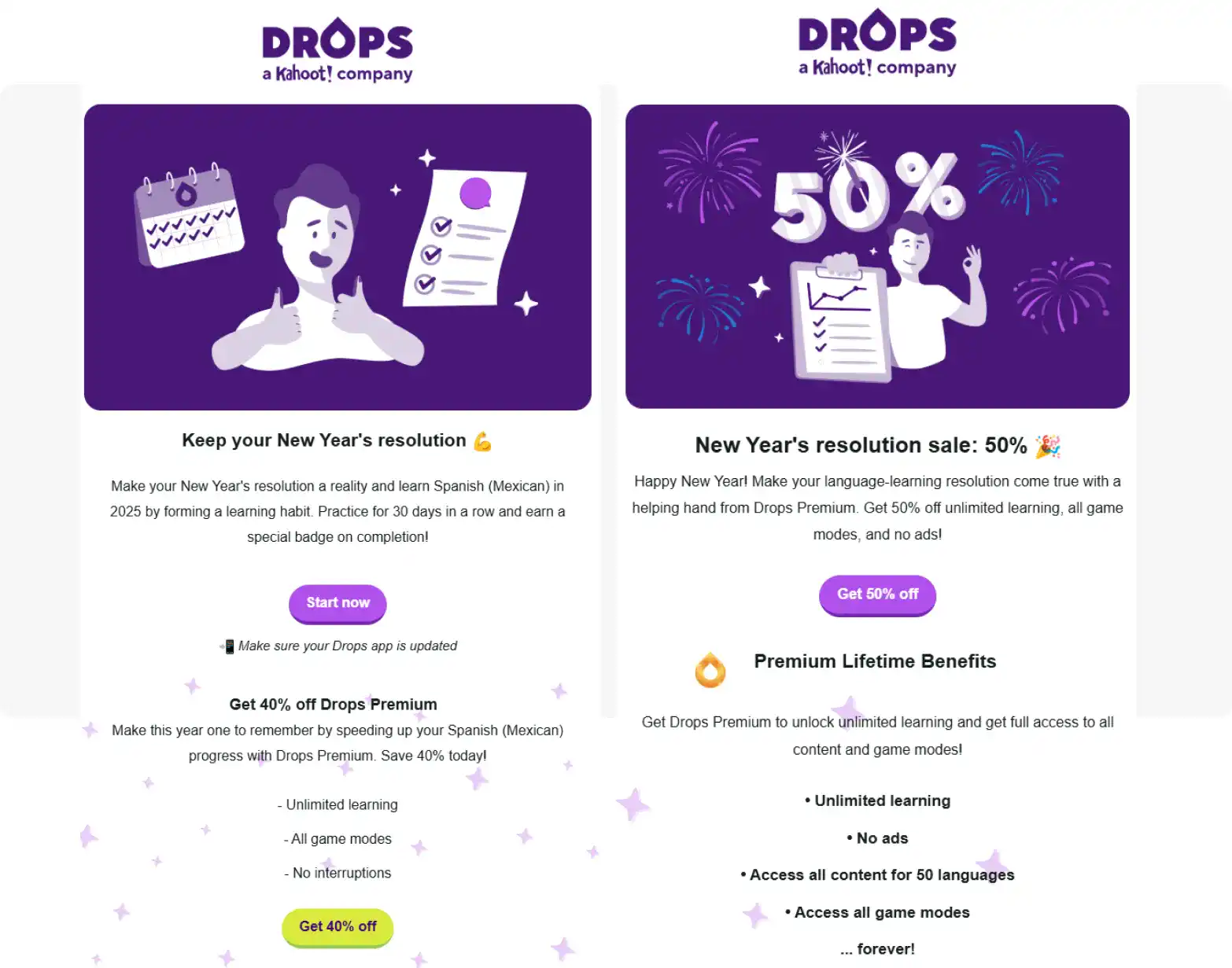
Holiday promo email template
🎄 If you’re planning a holiday marketing campaign, you can use ready-to-send holiday email templates to speed up your workflow.
Here’s an example of a promotional holiday email template you can start with:

🛠️ How to use this template: Log in to Pushwoosh’s drag-and-drop email editor, click Create email content → choose a holiday template → click Use a template, and customize it in minutes.
Power your holiday marketing campaigns with Pushwoosh
Holiday campaigns that rely on automation outperform manual sends by up to 3X, especially when messages are timely, personalized, and cross-channel.
With Pushwoosh’s holiday marketing automation, you can orchestrate push notifications, email, in-app messages, and SMS campaigns that react to every user action in real time — turning every opportunity into a conversion.





